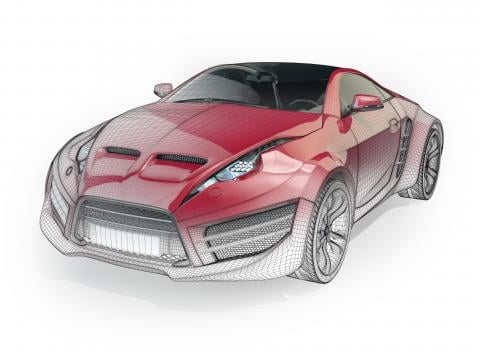Most problems require more than one engineer to solve. Take for instance the design of an automobile.
This is a hugely complex system that includes thousands of smaller problems that need to be solved. Some examples of the engineering disciplines required can be seen in the list below.
Acoustical Engineers might work on minimizing road noise within the car, or improve the design of the car’s stereo and speaker system, or even work to improve the sound of the cars engine.
Aeronautical Engineers would be involved in improving the aerodynamics of the car to reduce drag and maximize gas mileage.
Automotive Engineers are a specialized type of engineers who utilize the skills of many of the other branches of engineering listed here, and would be involved in most aspects of the car design.
Ceramic Engineers work with inorganic, non-metal materials, and might develop special ceramic composites (combinations of multiple materials) for use in heat shielding, or bearings. Some high-end cars use specially engineered ceramic brakes.
Computer Engineers would be involved in creating the firmware (software embedded in the car’s microchips) of the car.
Control Engineers, Electrical Engineers, and Electronic Engineers would work on designing & integrating the car’s electrical system, software, and sensors.
Environmental Engineers would be involved in making sure the car meets all emissions requirements.
Heating, Venting, Refrigerating & Air-Conditioning Engineers might be involved in creating the car’s heat and air conditioning systems.
Systems Engineers & Industrial Engineers would be involved in the management and supervision of the car creation process.
Manufacturing Engineers would determine how to make the individual components of the car.
Materials Engineers would help create new materials for use in the car construction.
Mechanical Engineers would work on the design of the mechanical aspects of the car; anything from the transmission to the engine to the suspension to the design of the snaps that hold the seats onto the frame.
Optical Engineers work on lenses and other optical instruments. They would design the car’s mirrors and windows.
Plastics Engineers would create plastic types for use in the car’s construction.
Process Engineers would be required to determine the best way to make the car and to ensure it is built correctly.
Structural Engineers might be involved in the creation of the car’s chassis and frame.
Thermal Engineers would work on the complex heat transfer systems, such as the engine cooling and exhaust.
That is only part of the huge team required! Diversity of knowledge isn’t the only reason for engineering teams. Even if there were one engineer out there who possessed all the knowledge listed above, more than one engineer would still need to be used. All individuals are shaped by their backgrounds and their experiences; these experiences serve to create their viewpoints. Multiple viewpoints are hugely beneficial when trying to find creative solutions to complex problems, as expressed by the cliché “two heads are better than one.” The more viewpoints looking at a problem, the more likely the problem will be solved. Of course the most obvious reason one would need multiple engineers working to design a car is that designing a car is a LOT of work for one person; the workload needs to be spread out among multiple people to get it done in a timely fashion!
WORKING ON A DESIGN TEAM:
Every student involved in competition robotics will have the opportunity to work on a design team at some point. There are a number of considerations they should keep in mind to achieve success:
- One should always keep an open mind. It is important to allow crazy ideas to develop. The most likely time for a creative solution to be found is early in the design process when wild ideas are expressed.
- No one should become overly attached to any single idea - especially one they created. It is easy to become blinded to other ideas simply because “they aren’t mine.”
- One should not become defensive regarding the opinions of others. Defend one’s own opinions and ideas but always focus on the ultimate goal of providing the best solution possible.
- One should always stay positive, even when discussing negatives.
- Engineering is based in logic. One should focus on factual arguments, not those based on opinions. Emotion should not be allowed to interfere with the process.
- It is important not to be offended if disagreements occur, even if things get heated and criticisms are overly harsh. Most engineers get passionate during design discussions and will often be very blunt. It is important not to take this personally.
- An unjustified opinion is not useful. Team members must be able to describe WHY they like or dislike something.
- This is NOT rhetoric, it is engineering. In rhetoric, the person who argues best will be most persuasive. In engineering, the person who has the best argument will be most persuasive. It is not the one who can speak the best but the one who can provide quantitative proof that will win an argument and prove their idea is better! It is important to be quantitative wherever possible.
The term “quantitative” is used a lot when discussing engineering arguments or justifications, but what does this really mean?
quan·ti·ta·tive (adj.)
- Expressed or expressible as a quantity.
- Of, relating to, or susceptible of measurement.
- Of, or relating, to number or quantity.
Quantitative arguments are simply ones that can be measured! In a design discussion, these are extremely valuable. As stated above, it is important to be quantitative whenever possible. For instance, the statement “that option is heavier, so I don’t think the extra functionality it provides is worth it,” is not nearly as valuable as saying, “That option weighs 50% more based on my initial estimates. Do we want to accept this additional weight for the functionality it provides?”

